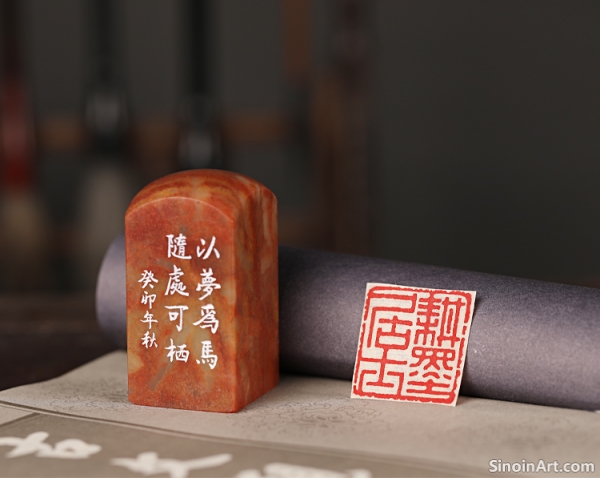The Tools of the Trade: Essential Equipment for Seal Carving
|
The art of seal carving demands not only artistic talent but also a keen understanding and skillful use of specialized tools. The tools of the trade have evolved over centuries and are crucial for shaping and incising characters on the stone surface. Each tool is designed to perform a specific function, and mastery of these tools is essential for producing high-quality name seals. The tools are simple, but their manipulation requires years of practice.  At the heart of seal carving are the carving chisels, or knives, known as zhuanke dao (篆刻刀). These are not the large chisels used in stone sculpture, but small, precisely made tools with sharp, angled blades. Carvers use a variety of chisels, each with different blade sizes and shapes, to create various stroke thicknesses and detail levels. The chisels are traditionally made of high-quality steel, and regularly need sharpening to ensure clean cuts.  The process of seal carving also requires a variety of other tools. A grinding stone or mòshí (磨石) is used to sharpen the chisels, while a polishing stone or pàogāngshí (拋光石) is used to smooth and polish the surface of the stone before carving. The stones come in a variety of fineness, for different stages of polishing and shaping of the stone, and the chisels.  A seal holder or yìnchuáng (印床) is used to securely hold the stone in place during the carving process. Often made of wood, these holders come in a variety of forms, often adjustable. Other tools include rulers, markers, brushes, and carving boards which assist in the carving process. These tools, though seemingly simple, are all essential for the precision and detail required in seal carving. The selection and maintenance of carving tools are just as important as the carving itself. A well-maintained set of tools allows the seal carver to work efficiently and precisely, achieving clean lines and smooth surfaces. The longevity and accuracy of the carving tools are a reflection of the carver's care and their level of dedication to their craft. The mastery of the tools in seal carving is often the result of years of practice. A skilled carver knows how to select the right tool for each step of the process, and how to control the tool to create the desired aesthetic effects. The precision and control offered by the tools are integral to the art of zhuanke, the art of carving name seals. |
Tag : Seal Carving Tools, Chinese Carving Chisels, Seal Engraving Equipment, Zhuanke Tools, Stone Carving Tools
Related information
- Collecting Leisure Seals: Understanding Artistic and Cultural Value
- The Role of Leisure Seals in Chinese Art and Literature
- Modern Uses of Collector's Seals: Adaptation and Evolution
- The Significance of Studio Seals: An Introduction to Zhaiguan Yinzhang
- The Art of the Name Seal: An Introduction to Chinese Personal Seals
This article offers a guide to collecting leisure seals, with insights on assessing artistic value, understanding the importance of provenance, and navigating the market for these unique objects.
This article explores how leisure seals are used in Chinese painting, calligraphy, and literary works, adding a personal touch, aesthetic dimension, and layer of cultural meaning to these art forms.
This article explores how collector's seals are used in the modern era, examining contemporary practices and the ways in which artists and collectors are adapting this tradition to new contexts and purposes.
This article introduces the concept of Chinese studio seals, exploring their historical context, cultural significance, and how they differ from personal name seals.
This article introduces the concept of Chinese name seals, exploring their history, cultural significance, and the basic techniques involved in their creation.